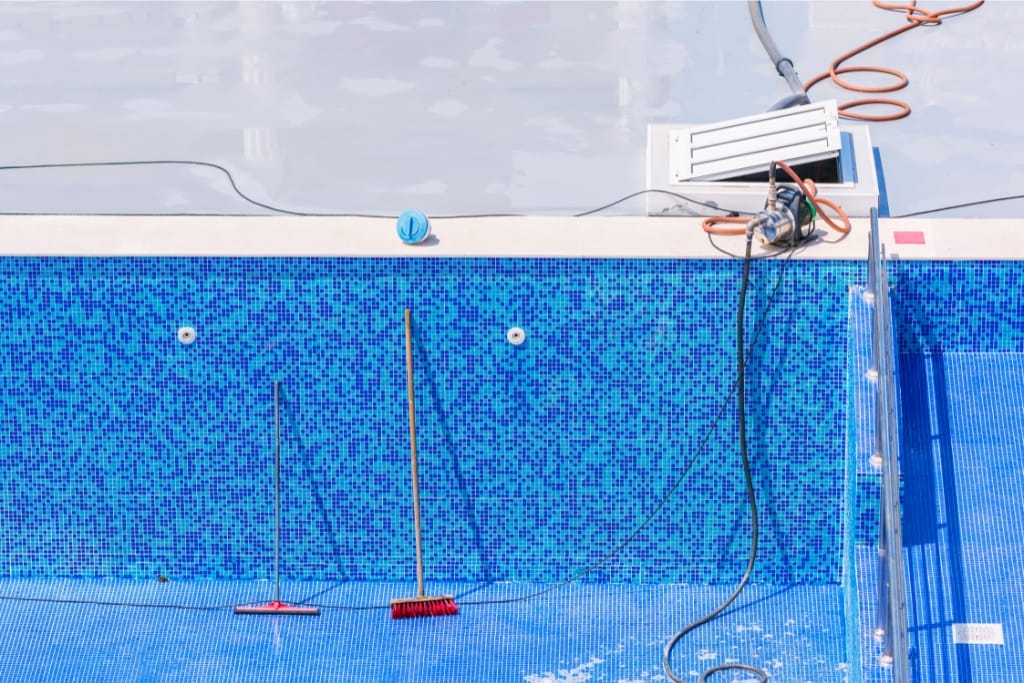Maintaining a pristine pool can elevate your backyard retreat into a private oasis, where every swim promises refreshment and relaxation.
Sparkling pool tiles not only enhance the aesthetic appeal but also contribute to the overall hygiene of your swimming environment.
With simple do-it-yourself tips, you can keep your pool tiles looking brand new between professional cleanings.
Ready to transform your pool from dull to dazzling?
Let’s explore the essential steps to achieve a crystal-clear finish.
1)) Use A Gentle Vinegar Solution For Regular Cleaning
A gentle vinegar solution is an excellent, eco-friendly choice for regularly cleaning pool tiles.
To prepare the solution, mix equal parts of white vinegar and water. This natural cleaner is effective at dissolving calcium deposits and removing grime without damaging the tile surface.
Apply the mixture using a soft sponge or cloth, gently scrubbing the tiles to remove any buildup.
Regular application of this solution can help keep your pool tiles looking fresh and vibrant.
By incorporating this simple routine into your pool maintenance, you'll enjoy a cleaner, more inviting swimming environment all season long.
2)) Brush Tiles With A Soft-Bristle Brush Weekly
Regularly brushing your pool tiles with a soft-bristle brush is a simple and effective way to prevent dirt and calcium buildup.
A weekly brushing routine can help dislodge any residual debris that settles on the surface of your tiles.
Soft-bristle brushes are gentle enough to avoid scratching or damaging the tiles, yet robust enough to effectively clean away unwanted particles.
Focus on areas that tend to collect dirt more easily, such as corners or shaded sections of the pool.
By maintaining this practice, your pool will not only stay cleaner but also reduce the likelihood of stubborn deposits forming.
Make it a part of your weekly pool maintenance, and over time, you'll notice a significantly more polished and well-maintained pool area.
3)) Incorporate Baking Soda For Tougher Stains
Baking soda is a powerful ally when facing tougher stains on your pool tiles. Its mild abrasive nature makes it ideal for dealing with persistent grime without causing damage to the tile surface.
Start by forming a paste using baking soda and a small amount of water. Apply this paste to the stained areas and use a cloth or sponge to scrub gently in circular motions.
The baking soda will work to break down and lift the stains, leaving your tiles looking refreshed.
This method is particularly useful for removing stubborn marks that other cleaning solutions might not handle effectively.
By integrating baking soda into your cleaning routine, you can easily tackle challenging stains, ensuring your pool tiles remain immaculate and inviting all year round.
4)) Implement A Routine For Skimming Debris
Establishing a routine for skimming debris from your pool is essential to maintaining its cleanliness and preventing unsightly buildup on your tiles.
Leaves, bugs, and other debris that accumulate on the surface can contribute to algae growth and stains if left unchecked.
Using a skimmer net, make it a habit to remove debris daily or at least several times a week.
This proactive step will help prevent organic materials from sinking and causing more extensive cleaning issues.
Regular skimming not only supports the visual appeal of your pool but also enhances the efficiency of your filtration system by reducing its workload.
By consistently skimming your pool, you're ensuring a cleaner, more appealing swimming area that invites enjoyment and relaxation throughout the season.
5)) Regularly Check And Balance Water Ph Levels
Maintaining the correct pH levels in your pool plays a pivotal role in preserving the integrity of pool tiles and ensuring a safe swimming environment.
The ideal pH range for pool water is typically between 7.2 and 7.8, which helps prevent corrosion of tiles and grout, as well as irritation to swimmers' skin and eyes.
Checking your pool's pH levels regularly and adjusting them as needed is crucial in preventing the growth of algae and the buildup of mineral deposits on tiles.
Use pool testing kits to monitor the water composition and utilize pH increasers or decreasers to maintain balance.
By paying attention to water chemistry regularly, you actively safeguard the condition of your pool tiles and contribute to a healthier, more enjoyable swimming experience.
6)) Utilize A Commercial Tile Cleaner For Deep Cleaning
For achieving a thorough clean, particularly when dealing with stubborn residues or extensive calcium deposits, utilizing a commercial tile cleaner is an effective solution.
These cleaners are specially formulated to break down tough stains and scale buildup without causing harm to your pool tiles.
To ensure optimal results, follow the manufacturer's instructions closely and apply the cleaner with a soft brush or sponge.
Working in sections, allow the cleaner to sit for a few minutes, enabling it to penetrate and dissolve the debris before rinsing thoroughly with water.
This deep-cleaning approach works in synergy with your regular maintenance practices to deliver superior tile cleanliness.
By incorporating commercial tile cleaners into your cleaning regimen when necessary, you maintain the look and extend the life of your pool tiles, keeping your pool pristine and inviting for swimmers year-round.
7)) Employ A Pumice Stone For Calcium Buildup
A pumice stone is an excellent tool for tackling calcium buildup on your pool tiles, which, if left untreated, can mar their appearance and lead to greater maintenance challenges.
The abrasive nature of pumice makes it especially effective at scraping away hardened calcium deposits without damaging the tile surface.
To use this method, wet the pumice stone and the affected area thoroughly.
Gently rub the stone over the calcium deposits using light, circular motions, gradually wearing away the buildup.
This hands-on approach provides precise control and can reach crevices difficult for other tools or chemicals, making it a preferred choice for pool owners targeting specific trouble spots.
By integrating the use of a pumice stone into your regular pool maintenance routine, you ensure that any calcium buildup is managed efficiently, thereby preserving the appearance and longevity of your pool tiles.
8)) Consider A Nylon Scrub Pad For Stubborn Spots
When dealing with particularly stubborn spots on your pool tiles, a nylon scrub pad can be an effective cleaning tool.
Its durable and flexible nature allows it to tackle tough stains and grime without scratching the surface of the tiles.
To use, simply apply a suitable cleaning solution to the affected areas and gently scrub using the nylon pad in circular motions.
This method provides the necessary abrasion to lift difficult spots without causing damage, making it ideal for delicate tile surfaces.
Nylon scrub pads are also resistant to degradation by pool chemicals, ensuring that they remain a reliable tool throughout the cleaning process.
By incorporating a nylon scrub pad into your cleaning arsenal, you can efficiently address persistent tile stains, contributing to the longevity and aesthetic appeal of your pool.
9)) Rinse Tiles With Fresh Water After Swimming Sessions
Rinsing your pool tiles with fresh water immediately after swimming sessions is a simple yet effective maintenance practice.
This routine helps to wash away residual chlorine and other chemicals that swimmers might bring into the pool, potentially reducing the buildup of chemical residues on your tiles.
Regular rinsing keeps your tiles looking pristine and minimizes the likelihood of corrosion or staining that can be caused by lingering pool chemicals.
Utilize a garden hose or a gentle spray to thoroughly rinse the waterline tiles after each swim.
This habit not only aids in prolonging the lifespan of your tiles but also ensures that they remain bright and inviting.
Implementing this quick step in your pool care routine contributes to overall maintenance by making more intensive cleaning less frequent and extending the beauty and functionality of your pool environment.
10)) Schedule Periodic Tile Sealing To Protect Against Stains
Scheduling periodic tile sealing is an essential preventative measure to protect your pool tiles against stains and prolong their pristine appearance.
Tile sealants create a protective barrier that prevents water, grime, and pool chemicals from penetrating the porous surfaces of your tiles, which effectively reduces the risk of stains or discoloration occurring over time.
To maximize the effectiveness of the sealant, it's important to choose a product recommended for pool tiles and follow the application instructions carefully, typically involving cleaning the tiles thoroughly before sealing and allowing adequate drying time.
Regularly assessing the condition of the sealant and reapplying it as needed ensures continuous protection and enhances the durability of the tiles.
By integrating periodic tile sealing into your pool maintenance strategy, you safeguard the beauty and longevity of your pool, maintaining an inviting environment that is easy to manage and aesthetically pleasing for years to come.
Conclusion
By following these effective pool tile maintenance strategies, you can significantly enhance the appearance and longevity of your pool, ensuring it remains a source of enjoyment for years to come.
Each method provides a targeted approach to tackle and prevent common issues like staining, calcium buildup, and chemical damage, thereby minimizing longer-term maintenance challenges.
Regular assessment and integration of these techniques into your routine not only preserve the aesthetic appeal of your pool tiles but also contribute to a safer and more pleasant swimming environment.
Embracing such diligent maintenance practices represents an investment in the quality, functionality, and visual charm of your pool, creating a welcoming oasis for relaxation and recreation.
Download Our Free E-book!








